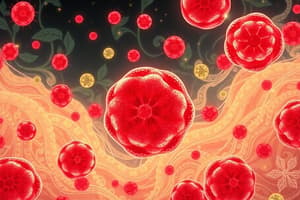Podcast
Questions and Answers
How many plasma coagulation factors have been identified?
How many plasma coagulation factors have been identified?
- 10
- 15
- 14 (correct)
- 13
What is the function of Factor XIII?
What is the function of Factor XIII?
- Stabilizes the fibrin clot (correct)
- Converts fibrinogen into fibrin
- Activates the extrinsic pathway
- Accelerates the conversion of prothrombin to thrombin
What is the common pathway of the coagulation cascade?
What is the common pathway of the coagulation cascade?
- The extrinsic pathway
- The intrinsic pathway
- The pathway that leads to the formation of fibrinogen
- The pathway that leads to the formation of thrombin (correct)
What is the function of Factor VIII?
What is the function of Factor VIII?
What is the result of the coagulation cascade?
What is the result of the coagulation cascade?
What is the deficiency that leads to hemophilia A?
What is the deficiency that leads to hemophilia A?
Flashcards are hidden until you start studying
Study Notes
Plasma Coagulation Factors
Overview
- Plasma coagulation factors are proteins in the blood that play a crucial role in the coagulation cascade, which helps to form blood clots and stop bleeding.
- There are 13 identified plasma coagulation factors, each with a specific function in the coagulation process.
The Coagulation Cascade
- The coagulation cascade is a series of chemical reactions that ultimately lead to the formation of a blood clot.
- The cascade involves two pathways: the intrinsic pathway and the extrinsic pathway, which converge to form the common pathway.
- The common pathway leads to the formation of thrombin, which converts fibrinogen into fibrin, resulting in a blood clot.
Plasma Coagulation Factors and Their Functions
- Factor I (Fibrinogen): converted into fibrin by thrombin
- Factor II (Thrombin): converts fibrinogen into fibrin
- Factor III (Tissue Factor): activates the extrinsic pathway
- Factor IV (Calcium): essential for many coagulation reactions
- Factor V (Proaccelerin): accelerates the conversion of prothrombin to thrombin
- Factor VII (Proconvertin): activates the extrinsic pathway
- Factor VIII (Antihemophilic Factor): essential for the intrinsic pathway
- Factor IX (Christmas Factor): essential for the intrinsic pathway
- Factor X (Stuart-Prower Factor): activates the common pathway
- Factor XI (Plasma Thromboplastin Component): activates the intrinsic pathway
- Factor XII (Hageman Factor): activates the intrinsic pathway
- Factor XIII (Fibrin-Stabilizing Factor): stabilizes the fibrin clot
Deficiencies and Disorders
- Deficiencies in plasma coagulation factors can lead to bleeding disorders, such as hemophilia A (Factor VIII deficiency) and hemophilia B (Factor IX deficiency).
- Other disorders, such as thrombophilia, can result from abnormal plasma coagulation factor function.
Plasma Coagulation Factors
- Plasma coagulation factors are proteins that play a crucial role in the coagulation cascade, helping to form blood clots and stop bleeding.
The Coagulation Cascade
- The coagulation cascade is a series of chemical reactions that lead to the formation of a blood clot.
- The cascade involves two pathways: the intrinsic pathway and the extrinsic pathway, which converge to form the common pathway.
- The common pathway leads to the formation of thrombin, which converts fibrinogen into fibrin, resulting in a blood clot.
Plasma Coagulation Factors and Their Functions
- Factor I (Fibrinogen): converted into fibrin by thrombin.
- Factor II (Thrombin): converts fibrinogen into fibrin.
- Factor III (Tissue Factor): activates the extrinsic pathway.
- Factor IV (Calcium): essential for many coagulation reactions.
- Factor V (Proaccelerin): accelerates the conversion of prothrombin to thrombin.
- Factor VII (Proconvertin): activates the extrinsic pathway.
- Factor VIII (Antihemophilic Factor): essential for the intrinsic pathway.
- Factor IX (Christmas Factor): essential for the intrinsic pathway.
- Factor X (Stuart-Prower Factor): activates the common pathway.
- Factor XI (Plasma Thromboplastin Component): activates the intrinsic pathway.
- Factor XII (Hageman Factor): activates the intrinsic pathway.
- Factor XIII (Fibrin-Stabilizing Factor): stabilizes the fibrin clot.
Deficiencies and Disorders
- Deficiencies in plasma coagulation factors can lead to bleeding disorders, such as hemophilia A (Factor VIII deficiency) and hemophilia B (Factor IX deficiency).
- Abnormal plasma coagulation factor function can result in disorders, such as thrombophilia.
Studying That Suits You
Use AI to generate personalized quizzes and flashcards to suit your learning preferences.




